Sailing in Ireland is a sport of long-lived organisations, writes W M Nixon. It’s a vehicle sport in which a significant number of the sailing vehicles are cherished classics, sometimes passed down from one generation to the next. Like it or not, we can never escape from our sailing history, for it’s often right out there, sailing along next to us, crewed by people whose parents sailed those boats before them. And then when we come ashore, it’s to clubs with every modern facility, yet those facilities are often skillfully incorporated with mature buildings redolent in history.
And what an extraordinary history it is. With the underlying tone of Irish sailing history being set by the fact the Royal Cork Yacht Club will be celebrating its Tricentenary next year, we can only hope that, somehow or other, we find the time and energy to take in our stride the many other special anniversaries which are cascading into the programme for this year and next.
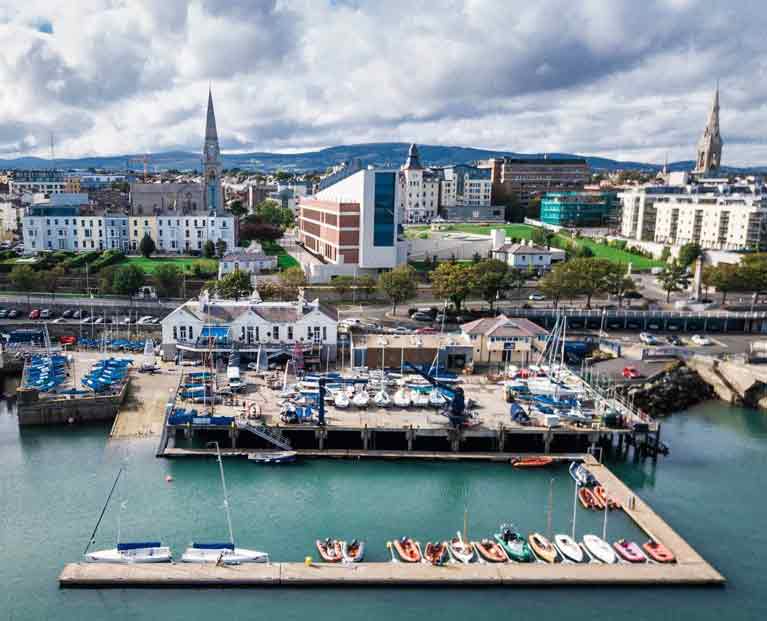 “Modern facilities incorporated with mature buildings redolent in history…” Dun Laoghaire’s National Yacht Club will be celebrating its 150th Anniversary in 2020.
“Modern facilities incorporated with mature buildings redolent in history…” Dun Laoghaire’s National Yacht Club will be celebrating its 150th Anniversary in 2020.
For the Royal Cork’s Tricentenary is something so big, so significant and so special that it’s quite a challenge just to take the idea of it on board. After all, the concept which was launched as the Water Club of the Harbour of Cork in 1720 has gradually permeated beyond the maritime world to become part of the broader culture, something which is brought home to us in the National Gallery in Dublin when contemplating Nathaniel Grogan’s 1765 painting of one of the yachts of the Water Club at Tivoli on Cork Harbour. In the painting, the boat in question – an extreme rarity in most other places – is clearly very much part of the local leisured life, and indicative of the way sailing sport has permeated Cork Harbour ever since.
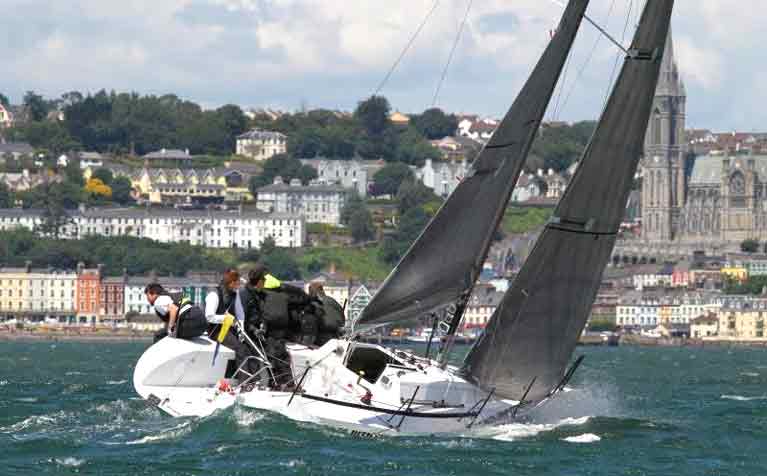 The racing in the biennial Volvo Cork Week well illustrates the way that sailing sport permeates Cork Harbour. Cork Week 2020 (July 13th to 18th) will be one of several highlights of the RCYC Tricentenary celebrations.
The racing in the biennial Volvo Cork Week well illustrates the way that sailing sport permeates Cork Harbour. Cork Week 2020 (July 13th to 18th) will be one of several highlights of the RCYC Tricentenary celebrations.
Fifty years ago, the Royal Cork celebrated its Quarter Millennium under the Admiralty of Clayton Love Jnr in a high profile two-year format, with a Transatlantic Race to Cork in 1969 which positioned American boats for that year’s Fastnet Race, and a big-fleet Cruise-in-Company of the leading cruising clubs to southwest Ireland.
With the two years available, the celebrations saw the second year devoted to more local interests, including an early Cork Week. But for 2020, and now half a century on, the world of sailing has changed almost beyond recognition, and high-powered events with a strong professional tinge dominate the heights of the annual global programme.
It is in these circumstances that the “2020 Committee”, headed by Colin Morehead, has been developing a programme suited to sailing and the Royal Cork YC as they are today, and their thinking for 2020 – when he will be Admiral – is that much of the programme will have an emphasis on accessibility, in giving all sailors a genuine feeling that the Royal Cork’s Tricentenary is something they can share.
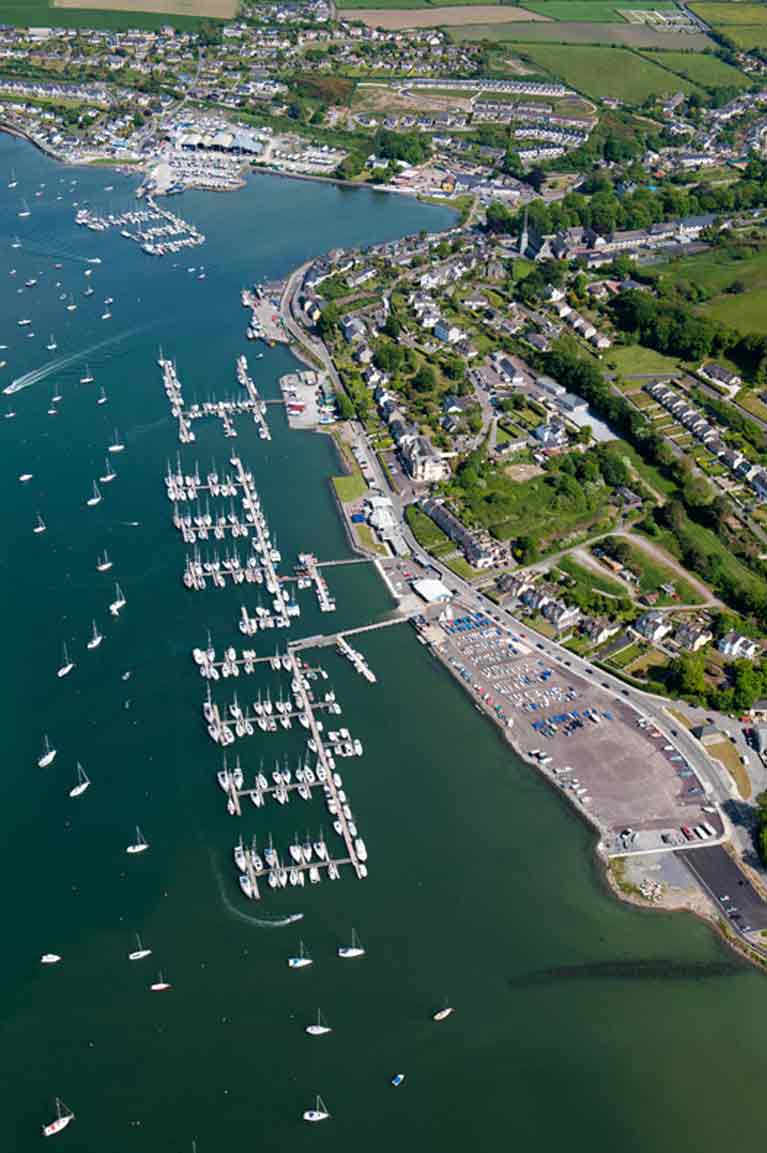 Facilities for our times. The Royal Cork YC may have three centuries of history, but the comprehensive waterfront facilities of Crosshaven are in contemporary style. Photo: Robert Bateman
Facilities for our times. The Royal Cork YC may have three centuries of history, but the comprehensive waterfront facilities of Crosshaven are in contemporary style. Photo: Robert Bateman
Certainly, the response and interest they have been receiving worldwide supports this generous yet realistic approach, and the Royal Cork is in the happy position of being well-placed in sailing’s global awareness. Its ultimate seniority was firmly acknowledged by the Royal Yacht Squadron when that premier club celebrated its 200th Anniversary in 2015, and back in 2005, the Royal Cork published its truly monumental history, written by professional historian Alicia St Leger, drawing on the magnificent collection of club artworks, artefacts and memorabilia curated by RCYC Honorary Archivist Dermot Burns.
Thus for the past fifty years and more, the foundations have been in the process of being laid for the events of 2020 in and around Cork Harbour, and the fact that the programme is being quietly developed without undue fanfare give a sense of realism to it all. For in truth, there is still an air of unreality to the very idea that a yacht club can be 300 years old.
DBSC Junior Section Golden Jubilee
In the meantime, other sailing communities are stepping up their own local special anniversaries, and they provide a rich selection.
Just this week, Dublin Bay SC revealed on Afloat.ie that its Junior Section began formal racing in the sheltered yet clear waters to the west of the West Pier back in 1959. With proper-job white-capped Officers of the Day, it marked the first stirrings of a seriously organised junior programme several years before the Irish Yachting Association (which was still the Irish Dinghy Racing Association in the 1950s) began to give the concept a national structure.
Yet if there was a Golden Jubilee celebration back in 2009 of that nascent West Pier setup, it slipped under the radar. But these days, with longer and still-active lives the norm, 60th Anniversary celebrations (you may call it the Diamond Jubilee if you wish) are readily possible, with many of the original participants still around to share in the fun, and they gather in the Royal St George YC on April 12th.
As for the parent organisation, Dublin Bay SC celebrated its Centenary way back in 1984 in considerable style when Michael O’Rahilly (The O’Rahilly, to give him his proper title) was Commodore. He’s still enjoying his sailing, these days with his son John aboard the latter’s recently-acquired award-winning cruiser Rike. When we met the other evening at the ICC AGM, Michael expressed a nostalgic wish for a sail aboard the champion Howth 17 Deiliginis, aboard which he spent many happy hours when she was the DBSC 17 Deliginis and based in Dun Laoghaire.
That friendly request encapsulated much of Irish sailing. In addition to being a very keen sailor, Michael O’Rahilly has done more that his share of voluntary duties to keep the show on the road, and much of it was done in the service of a very active club which nevertheless soared effortlessly through its Centenary all of 35 years ago.
In being an active participant in that club’s sport on the water, Michael had sailed in a boat which was already old – Deilginis was built by James Kelly of Portrush in 1907 – yet that same Deilginis - thanks to the efforts of Nick Massey and his family and partners – is now in immaculate classic-style order, and she is moreover the 1898-founded Howth 17 Class’s current champion.
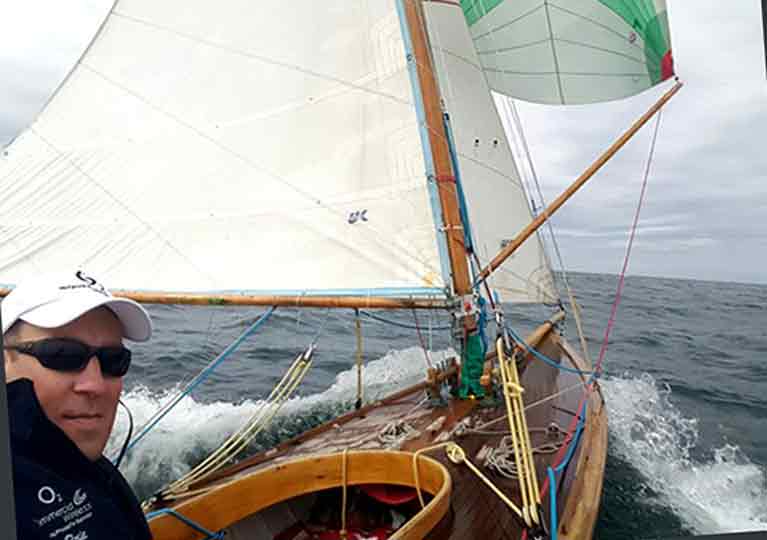 Still going strong. Helmsman’s selfie aboard the 1907-built Howth 17 Deilginis, on passage from Howth to Belfast Lough for the 150th Anniversary celebrations of the Royal Ulster YC in 2016. Photo: David Nixon
Still going strong. Helmsman’s selfie aboard the 1907-built Howth 17 Deilginis, on passage from Howth to Belfast Lough for the 150th Anniversary celebrations of the Royal Ulster YC in 2016. Photo: David Nixon
Faced with so many links running every which way, we’ll try to put some order on the next two years of celebration and commemoration in order of seniority, and if we’ve missed something, do please let us know.
- 2020 Royal Cork Yacht Club Tricentenary
- 2020 Lough Ree Yacht Club Quarter Millennium
- 2020 Lough Erne Yacht Club Bicentenary
- 2020 National Yacht Club 150th Anniversary
- 2020 Howth Yacht Club 125th Anniversary
- 2019 Seabird Half Rater 120th Anniversary
- 2019 Ballyholme Yacht Club Centenary
- 2019 Cove Sailing Club Centenary
- 2019 Treardur Bay Sailing Club Centenary
- 2019 Dublin Bay SC Junior Section 60th Anniversary
- 2019 Figaro Solo Golden Jubilee
- 2019 Coiste an Asgard Sailing Programme 50th Anniversary
- 2019 Glenans Ireland 50th Anniversary
- 2019 Fastnet Race Storm 40th Anniversary
- 2019 Sigma 33 40th Anniversary
- 2019 Cruinniu na mBad, Kinvara 40th Anniversary
40th Anniversary of the Fastnet storm
Not all are celebratory. The 40th Anniversary of the Fastnet storm of 1979, with its 15 deaths and five competing boats foundering, will be a matter of solemn remembrance this August in West Cork and in families now spread across the globe. Yet as has been austerely observed, the worst thing and the best thing about life is that it goes on.
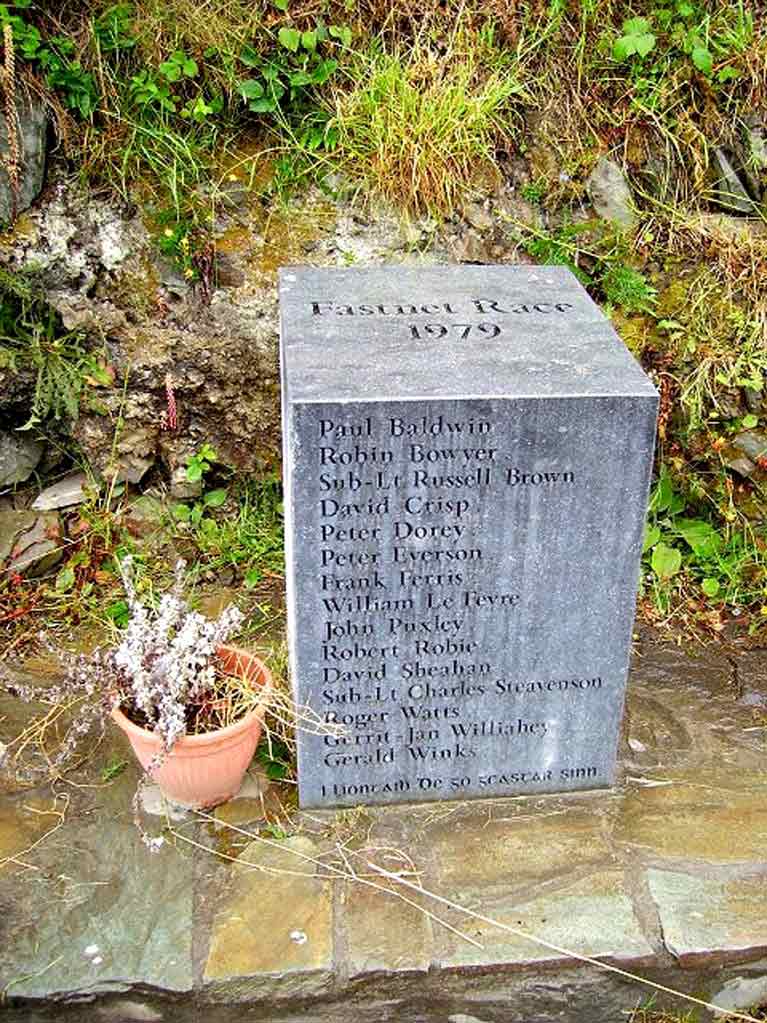 The simple memorial stone on Cape Clear remembering those who were lost in the Fastnet Race storm of 1979
The simple memorial stone on Cape Clear remembering those who were lost in the Fastnet Race storm of 1979
The Baltimore lifeboat of 1979, the Watson 47 Robert, brought in Ken Rohan’s Ron Holland-designed white-hot performer Regardless, the star of the then-leading Irish Admiral’s Cup Team, after she’d lost her rudder as the super-storm developed. The Robert – ON955 – is currently being restored by Jeff Houlgrave. He’s better known for his professional links to the world of superyachts, but restoring vintage lifeboats is his intriguing hobby, and all being well, the Robert will be back in Baltimore in August 2019.
For sure, that will remind us of an appalling two days that shook the world of offshore racing to its core 40 years ago, but it will equally remind us of many acts of exceptional heroism that ensured the death toll wasn’t higher, and tragic and all as it was, much was learned from it.
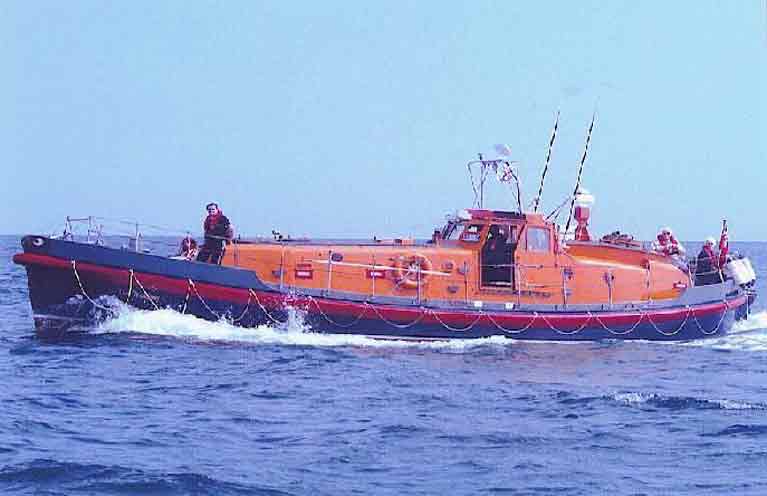 The Watson 47 type Robert was the Baltimore lifeboat in 1979
The Watson 47 type Robert was the Baltimore lifeboat in 1979
As for Regardless, she was fitted out with a stronger rudder stock, and sallied forth for the 1981 Admirals Cup series - rounded out by the Fastnet Race - with young fellows like Robert Dix, Drewry Pearson and Des Cummins in her crew. Heading into the first post-disaster Fastnet Race was a thoughtful experience, but Regardless emerged on top, first of all the Admiral’s Cup boats, and first overall in Class I.
For a while, the numbers in the Fastnet Race were reduced from 1979’s 300-plus, and even by 2007 when an exceptional gale was forecast, a majority of the fleet retired while still near shelter. But the overall winner was Ger O’Rourke’s Cookson 50 Chieftain, one of the great Irish sailing successes of the 21st Century.
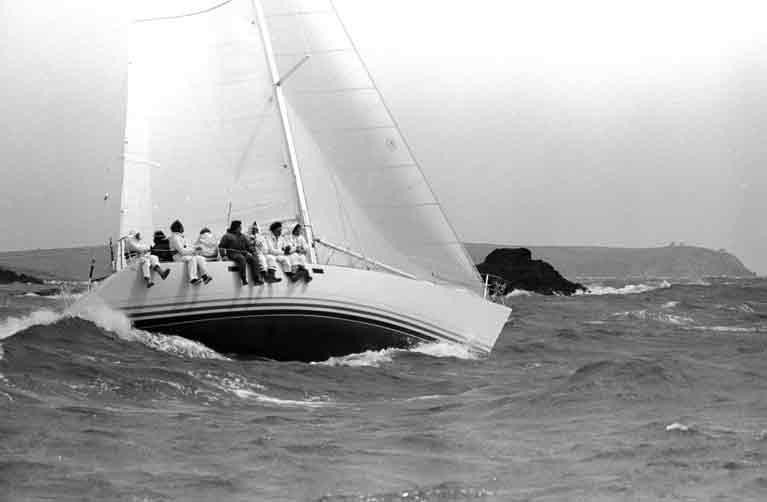 Life goes on…..Ken Rohan’s Regardless in the Irish Admirals Cup Trials of May 1981 in Cork is seen here coming out past the rocks of Roche’s Point in the winning form which she maintained to the end of the season, which included the first post-disaster Fastnet Race. Photo: W M Nixon
Life goes on…..Ken Rohan’s Regardless in the Irish Admirals Cup Trials of May 1981 in Cork is seen here coming out past the rocks of Roche’s Point in the winning form which she maintained to the end of the season, which included the first post-disaster Fastnet Race. Photo: W M Nixon
As for the Rolex Fastnet Race itself today, the figures speak for themselves. When the online entries for 2019 opened for business, 180 boats were in within the first two minutes, and after four minutes and 37 seconds, the maximum of 340 boats had been reached. But don’t lose heart if you’re only on the Waiting List. Back in 2007, Chieftain was on the Waiting List until the Tuesday before the weekend of the race’s start…….
The last three Fastnets have been won overall by French boats, and if we needed a further reminder of the pace-setting way of the French at the sharp end of offshore racing, the Golden Jubilee Solo URGO Figaro is making Kinsale a major part of its celebrations, with the fleet there around June 5th to 9th with an extended community-aimed programme.
Figaro's Golden Jubilee
As this will be the Figaro’s 20th time in Kinsale, it makes the Irish harbour the classic event’s most-visited port, and though the basic programme tells us the fleet will be in port for 3 to 5 days, it will have all the makings of a week-long sea festival, a friendly Gallic-flavoured Viking invasion.
 The Golden Jubilee of the Figaro Solo will see the fleet in Kinsale from June 5th to 9th, the 20th time this top-end single-handed classic has featured the south coast port.
The Golden Jubilee of the Figaro Solo will see the fleet in Kinsale from June 5th to 9th, the 20th time this top-end single-handed classic has featured the south coast port.
It’s going to be a Gold Plate entry for this Golden Jubilee event, with several of the superstars of yesteryear returning to take part in racing which will be staged in the new foiling Beneteau Figaro 3. Although our recently-appointed Irish Sailing Sustainability Ambassador Damian Foxall is the only Irish sailor to have won a Figaro leg, whether or not he’s back in the hunt won’t be known until April when the final starting lineup is published. But we do know that Tom Dolan of Meath with Smurfit Kappa and Joan Mulloy of Mayo have been allocated boats.
 The new Figaro 3 with foils makes its full-on debut with the Golden Jubilee Solo URGO Solitaire in June
The new Figaro 3 with foils makes its full-on debut with the Golden Jubilee Solo URGO Solitaire in June
250th Anniversary of Lough Ree YC
Descending from the giddy heights of the Golden Jubilee Figaro Solo in Kinsale in June this year, next year’s celebration of the 250th Anniversary of Lough Ree YC, the 150th of the National YC in Dun Laoghaire, and the 125th of Howth seem reassuringly local and manageable in concept, yet they’re all unique elements of a very special historic tapestry that we almost take for granted.
Be that as it may, events of this summer deserve our greatest consideration, and as Ballyholme YC on Belfast Lough is hitting the big one in 2019, our congratulations flow north to a club which has evolved successfully to accommodate changing sailing patterns. Although its keelboat fleet – including its flotilla of restored 1902-vintage Waverley Class sloops - is now berthed in Bangor Marina, at its home base on Ballyholme Bay it is beside clear open waters which provide one of Ireland’s best dinghy racing venues, a top choice for major events. And the club’s flexibility is shown through its readiness to provide powerboat training programmes.
 First sailed in 1902, the Waverley Class have been with Ballyholme Yacht Club since its foundation a hundred years ago.
First sailed in 1902, the Waverley Class have been with Ballyholme Yacht Club since its foundation a hundred years ago.
But while Ballyholme is in Ireland and familiar to many of our racing sailors, you might well wonder what on earth is the Centenary of Treardur Bay Sailing Club in North Wales doing in our list, not to mention the 120th Anniversary of the Seabird Half Rater Class, which likewise is largely North Wales-based.
The answer is found in the magnetic attraction of the Volvo Dun Laoghaire Regatta from July 11th to 14th 2019. You may recall that at the previous VDLR in 2017, one of the special classes was the classic Fifes from the Menai Straits, lovely little keelboats which were already known in Ireland from their starring roles at the Glandore Classics.
 The crowded anchorage of the 1919-founded Treardur Bay SC on Anglesey, In the foreground are 14ft dinghies of the local Myth Class (founded 1920) and beyond are some of the club’s Seabird Half Raters, part of a class which first sailed 120 years ago.
The crowded anchorage of the 1919-founded Treardur Bay SC on Anglesey, In the foreground are 14ft dinghies of the local Myth Class (founded 1920) and beyond are some of the club’s Seabird Half Raters, part of a class which first sailed 120 years ago.
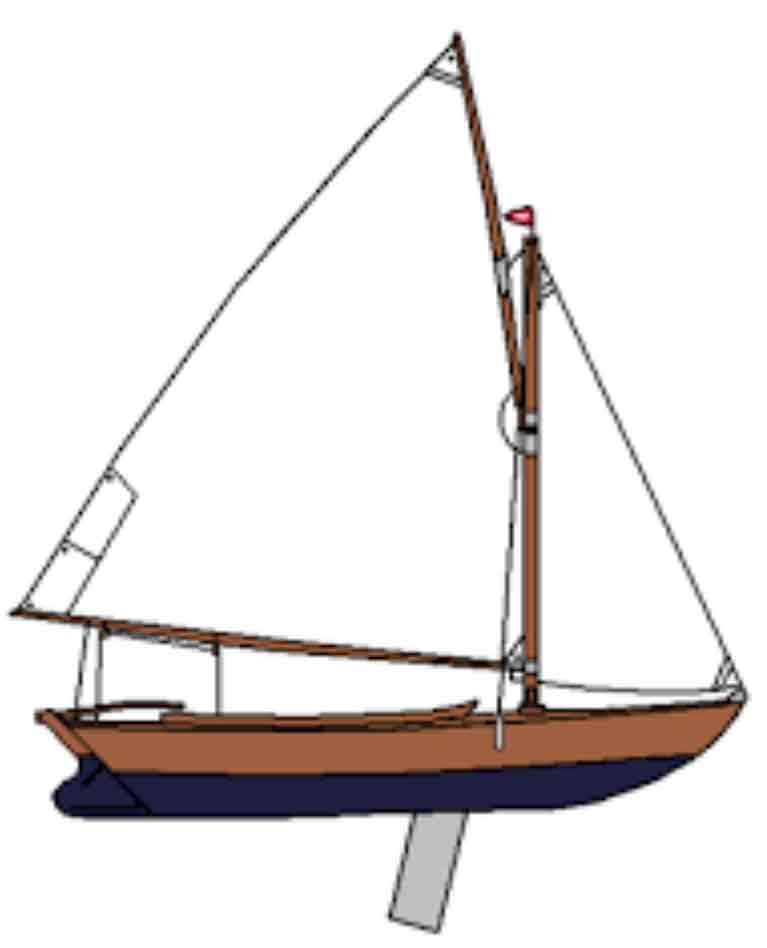 Profile of the 20ft Seabird Half Rater – their participation in the Volvo Dun Laoghaire Regatta 2019 will be watched with interest, as their keel/centreboard arrangement is unusual in Ireland
Profile of the 20ft Seabird Half Rater – their participation in the Volvo Dun Laoghaire Regatta 2019 will be watched with interest, as their keel/centreboard arrangement is unusual in Ireland
Well, it seems the good news has spread westward across Anglesey to Treardur Bay close south of Holyhead, where they’ve had an active sailing club since 1919. In all, at least 21 boats from Treardur Bay SC’s fleet will be brought over by trailers, made up from the Seabird Half Raters – 20ft LOA semi-keelboats designed by Scott Hayward of Lancashire for a class which first raced in 1919 – and TBSC’s own class, the clinker-built 14ft Myth Class which originated in 1920 to a commissioned design from Morgan Giles, who at much the same time was working in the first drawings for the Shannon One Design.
Like many such classes, the Myths went through a slim patch, but thanks to noted Anglesey boatbuilder John Jones (who has helped in the new vitality of the Dublin Bay Water Wags), the Myths are now in excellent health, and it’s going to be fascinating comparing their performance to the Water Wags in Dun Laoghaire in July.
 Shannon One Design making knots and then some. Designed by Morgan Giles at much the same time as he designed the Myths for Treardur Bay SC, the Shannon ODs will be playing a leading role in the Quarter Millennial Celebrations of Lough Ree YC in 2020.
Shannon One Design making knots and then some. Designed by Morgan Giles at much the same time as he designed the Myths for Treardur Bay SC, the Shannon ODs will be playing a leading role in the Quarter Millennial Celebrations of Lough Ree YC in 2020.
In fact, even for people who normally avoid history if at all possible, these next two years in Irish sailing are going to be intriguing. And if anyone thinks they can comprehend - in a genuinely meaningful way - all the things that have happened to the world since the Water Club of the Harbour of Cork started formalising its manoeuvres in 1720, then good luck to them. Many of the rest of us find it quite difficult to grasp, and we certainly don’t have the brain-space to explain why both Glenans Ireland and Coiste an Asgard are but shadows of themselves fifty years after they were founded.
































































